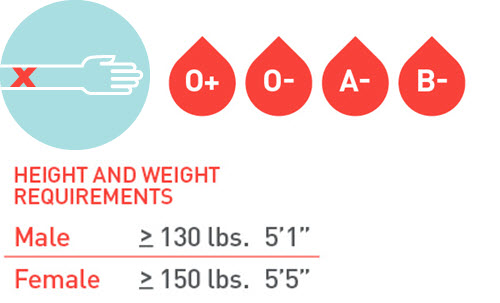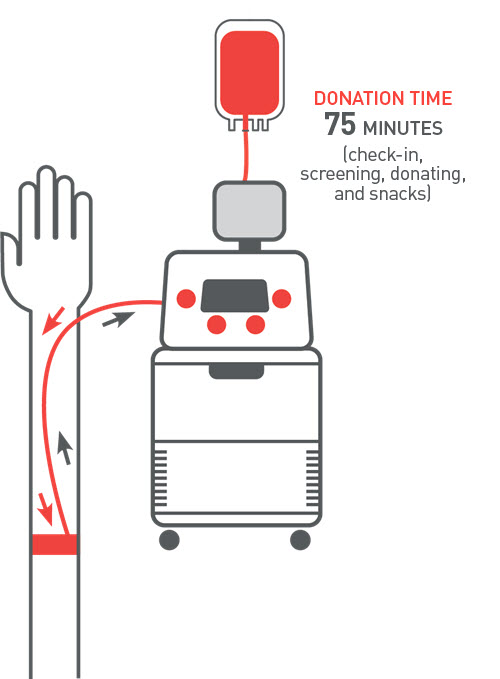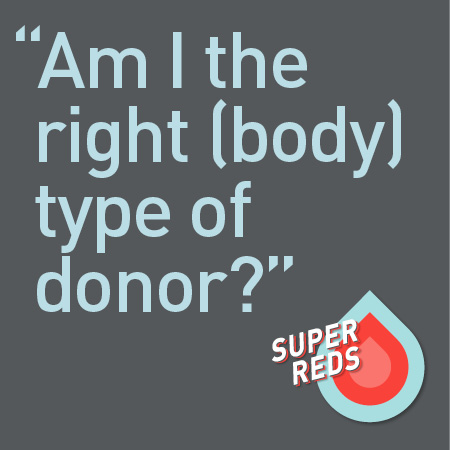Donating Super Reds
What is a Super Reds Donation?
If you are *blood type O+, O-, A-, or B- and have limited time throughout the year, this may be the perfect donation for you! In a single visit, you are able to donate enough red blood cells for two transfusions through apheresis (ay-fur-ee-sis), an automated process that only collects your red blood cells, returning your platelets and plasma to your body. This donation results in twice as many red cells-enough
for two patients.
Did you know?
A Super Reds donor is able to donate three times a year with the same impact as donating whole blood six times a year!
*Other blood types may be needed depending on inventory.
Help out today!
When Super Red donations are needed
A Super Reds donation is at its most critical need when we see our blood supply take a dip. This donation type helps us meet the local demand for red blood cells more efficiently and quickly.
What are the benefits of a Super Reds donation?

A single donation can help two patients receive lifesaving treatment for trauma, surgeries, cancer, and bleeding disorders. With Super Reds, it only takes three donations to hit the max number of times to give in a year. That means max support for local patients with less visits to donate.
The ideal Super Reds donor


If you are Type O+, O-, A-, or B-, and meet the minimum blood volume requirements determined by weight, height, and hemoglobin level, you are eligible to be a Super Reds donor. A Blood Collections Specialist will review these eligibility requirements with you during the screening process.
*Washington and Oregon have different requirements for 16 & 17 year-old donors. Learn more about eligibility.
Super Reds donation process


Through a process called apheresis, blood is drawn from your arm to a sterile, one-use-only kit in an apheresis machine that spins the blood to remove just the red blood cells, returning the platelets and plasma to your arm. This process takes about seventy-five minutes while you read or stream movies. We appreciate your time, and your community appreciates your donation.
Other Types of Blood Donations:

Why would donating Super Reds be more beneficial than whole blood?
It doubles your impact! By donating Super Reds, you safely donate the equivalent of two red cell transfusions during one visit. Other benefits: It saves you time since you donate Super Reds just three times a year. Plus, a smaller needle is used compared to whole blood donation!
What is a Super Reds Donation?
A single donation can help two patients receive lifesaving treatment for trauma, surgeries, cancer, and bleeding disorders. With Super Reds, it only takes 2 donations to hit the max number of times to give in a year. That means max support for local patients with less visits to donate.
What are red blood cells?
Red blood cells deliver oxygen throughout your body and are the most commonly transfused blood component – vital to patients with severe blood loss or sickle cell disease.
How does the process work? What should I expect?
The apheresis process is simple: Blood is drawn into a sterile kit in a special machine returning your plasma with additional saline (fluid). And of course, the process is completely supervised and safe for you!
How long does it take?
The entire visit, from registration to refreshments, typically takes about 75 minutes. You may watch television or movies, listen to music, read, or simply sit back and relax while helping save a life.
Do I need to prepare differently than a Whole Blood donation?
Nope. We recommend you come in having had a good meal and plenty of water as you would a Whole Blood donation.
Is it safe? Am I at a greater risk to experience side effects?
Each donation is closely supervised by trained staff. The amount of red cells collected does not compromise your health, and the volume replacement (saline solution) helps replenish your fluids to avoid any side effects. Some people even feel refreshed because of the returned blood components and fluid. New, sterile donation equipment (needle, tubing, collection bags) is used for each donor – it is virtually impossible to contract a disease from the process. And, if you’re curious, you can watch the whole process happen!
Will I feel any different than when I donate whole blood?
No difference. In fact, donors often feel better when donating Super Reds because only the red cells are collected, and they are getting all that awesome saline, platelets, and plasma back.
What are the specific requirements?
Apheresis red cell donors are most commonly *blood type O+, O-, A-, or B- and meet minimum blood volume requirements determined by weight, height, and hemoglobin (for specific questions reach out). Donors must meet Hemoglobin (iron) requirements as listed here as well as meet weight requirements.
*Other blood types may be needed depending on inventory.
Why do you need specific blood types?
It takes donors of all blood types to maintain a stable community blood supply for patients. We want donors to be blood type O+, O-, A-, or B- for Super Reds because their types are the most needed for hospitals, depending on inventory other blood types might be needed as well. This donation type helps us meet the local demand for red blood cells more efficiently and quickly.
How often can I donate Super Reds?
Three times a year! You may donate apheresis red cells once 112 days compared to every 56 days for whole blood donation. Overall, this means more time in between appointments and fewer visits to Bloodworks.
How soon after donating Super Reds can I give whole blood, platelets, or plasma?
The waiting period is 112 days before your next whole blood, platelet, plasma, or Super Reds donation!
How do I become a Super Reds donor?
If you believe you meet the blood type, minimum height, weight requirements for Super Reds donation, you can book your first appointment by contacting us at 800-398-7888 or returning donors can schedule online. You can also schedule a Whole Blood appointment and talk to our staff about donating Super Reds!




